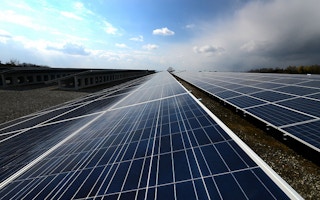What does a city powered entirely by renewable energy look like?
Ray Wills imagines a Sydney that, by 2025, is generating more energy than it’s consuming. Every home in the sunny Australian city has solar-paneled rooftops whose energy can be fed back into the grid or stored at home to be used later.
Luciana Nery sees a Rio de Janeiro that is more resilient in the future because it doesn’t need its power shipped from elsewhere. She cites a tantalising number: 187 per cent. That’s how much of the city’s energy needs could be generated through solar roofs.
And Colleen Giroux-Schmidt envisions a city where the streets are bustling but silent — all the cars and delivery trucks are powered by electricity. At her local cafe, breakfast is prepared on a super-efficient induction stove, the food has been grown in local gardens, and rooftop solar panels are generating energy.
People’s smartphones tell them not only how much energy they have used, but how much they have produced from their homes and vehicles.
Those were images of future cities presented at this week’s Renewable Cities’ Global Learning Forum in Vancouver.
“
One hundred per cent renewable energy has to be with 100-per cent community focus. If we don’t focus in the community, that’s not going to happen.
José Etcheverry, professor in environmental studies, York University in Toronto
Wills is the managing director of Future Smart Strategies and a professor at an Australian university; Nery is the undersecretary for innovation of management in Rio de Janeiro; and Giroux-Schmidt is a senior director at Innergex Renewable Energy in British Columbia.
They and others aimed to help an audience of more than 300 leaders from local governments, the private sector, utilities and the NGO and research communities break out of the current mindset of slow, incremental change.
They want to jump forward to the idea of sweeping transformation to cities powered by 100-per cent renewable energy.
Collective effort
Besides painting inspiring portraits of the future, they also emphasized the basic building blocks such a transformation will require.
The first one is that it has to be a collective effort. The whole public has to be engaged, attracted to the movement by compelling language and a sense of participation.
“One hundred per cent renewable energy has to be with 100 per cent community focus,” said José Etcheverry, a professor in the environmental-studies department of York University in Toronto and co-chair of the Sustainable Energy Initiative in that faculty. “If we don’t focus in the community, that’s not going to happen. The best way to engage with the community is through learning by doing.”
Etcheverry is also leading a new effort called the International Renewable Energy Academy. It will host a session this June, based on providing the public with opportunities to understand renewable energy using experiential-learning techniques.
Wills also emphasised that renewable-energy advocates have to get their message across in language that people who aren’t necessarily hard-core environmentalists will understand.
“The answer is with the support of the community, the participation of everyone,” said Wills. “But we need to know how to translate this message thoroughly.”
Beyond ‘net-zero’
Another theme was the need to move beyond simply working within the existing trendlines. Instead, said Vancouver’s chief planner, Gil Kelley, city officials and activists need to decide on the desired future and then work backwards to figure out what bold steps are needed to get there.
“In a way, what the first path leads you to is incremental change — and that’s all good,” Kelley said. “But the other leads to the possibility of transformative change.” He said Vancouver is on an aggressive path, requiring zero emissions from all new buildings by 2030; any developments requiring rezonings must meet the new rules as of May 1. Already, a rental building is being constructed to the rigorous “Passive House” standard.
Radical change, Kelley said, requires “looking at everything in the box to see how we get to that desired future.” He called on renewable-energy advocates to stop settling for “net-zero emission” buildings, vehicles and cities that produce as much energy as they consume. Instead, the goal should be to make these things “net positive” — producing more energy than they consume.
“For the last 100 years, we’ve been digging ourselves a very big hole,” Kelley said. “How do we actually give back?”
Wills also talked about a future beyond net-zero, where cities like Sydney can export energy. He pointed out that two-thirds of the world’s population lives in latitudes favourable to producing solar power, and two-thirds of the energy used is during the daytime, when solar energy can be captured. That is an encouraging foundation for an energy transformation.
Then the key is figuring out ways to transport that energy to help everyone.
“The future is here,” said Wells. “It’s just not well distributed.”
This story was published with permission from Citiscope, a nonprofit news outlet that covers innovations in cities around the world. More at Citiscope.org.

















